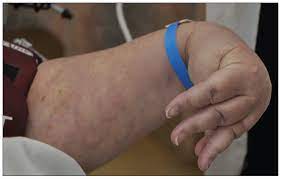A female client has a serum calcium level of 7.2 mg/dl. During the physical examination, nurse Noah expects to assess:
- A- Trousseau’s sign.
- B- Homans’ sign.
- C- Hegar’s sign.
- D- Goodell’s sign.
Answer A.
This client’s serum calcium level indicates hypocalcemia, an electrolyte imbalance that causes Trousseau’s sign (carpopedal spasm induced by inflating the blood pressure cuff above systolic pressure).Homans’ sign (pain on dorsiflexion of the foot) indicates deep vein thrombosis.
Hegar’s sign (softening of the uterine isthmus) and Goodell’s sign (cervical softening) are probable signs of pregnancy.
The most likely sign for nurse Noah to assess in this case is:a- Trousseau’s sign.
Here's why:
- Trousseau's sign:is a physical examination maneuver used to assess for neuromuscular irritability, which is a common symptom of hypocalcemia (low blood calcium).
- A serum calcium level of 7.2 mg/dl is significantly below the normal range (8.5-10.5 mg/dl), indicating hypocalcemia.
- Therefore, Trousseau's sign would be the most relevant indication of the client's potential hypocalcemia.
Let's briefly explain why the other options are not as likely:
b- Homans' sign:
This is used to assess for deep vein thrombosis (DVT) and is not typically associated with hypocalcemia.
c- Hegar's sign:
This is used to assess for pregnancy and is not relevant to the client's presenting condition.
d- Goodell's sign:
This is used to assess for cervical softening and is not typically used in general physical examinations.
While it's always important to perform a comprehensive physical examination, based on the available information, Trousseau's sign is the most specific and relevant assessment for this client with hypocalcemia.










